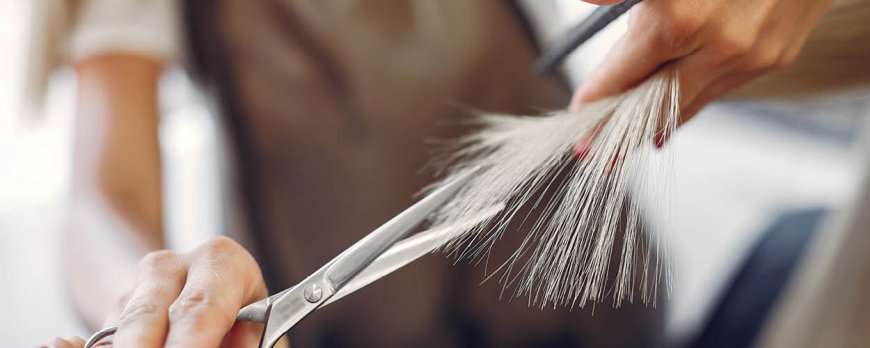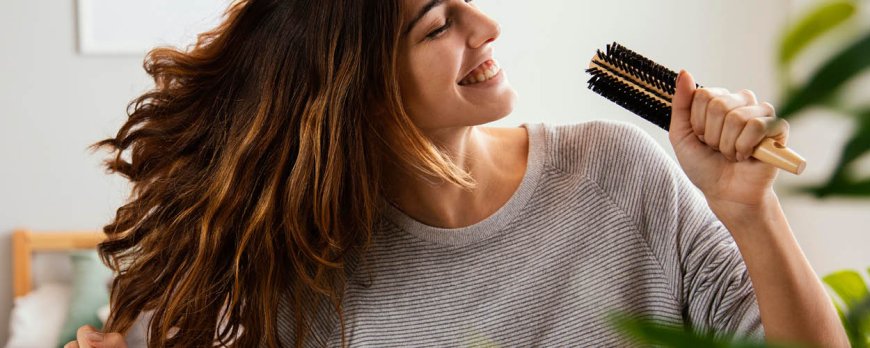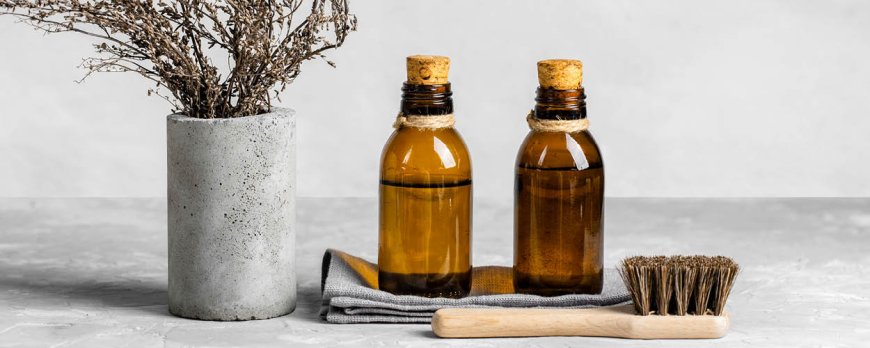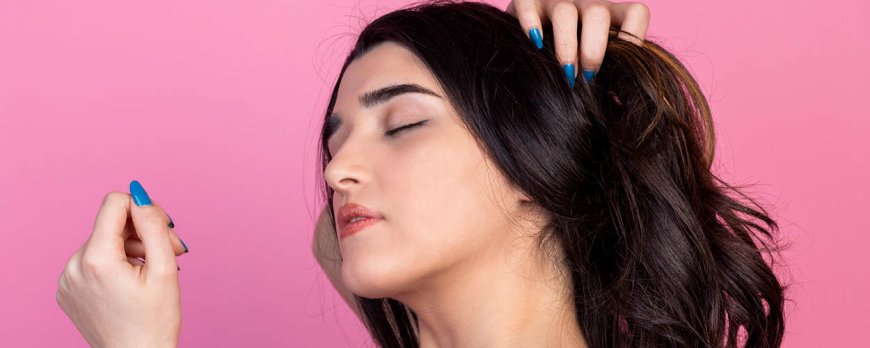Does damaged hair grow back healthy?
Unravel the answer to 'Does damaged hair grow back healthy?' Learn about hair growth, care and repair strategies for damaged strands in our guide.

Does damaged hair grow back healthy?
Damaged hair can be a source of frustration, but many people wonder if it is possible for their hair to grow back healthy again. The answer is not always clear-cut. While most hair damage is irreparable since hair is made up of dead cells that cannot be repaired, there are ways to improve the overall health and appearance of damaged hair. This article will explore the question of whether damaged hair can grow back healthy and provide insights into repairing and maintaining damaged hair.
Key Takeaways:
- Damaged hair, being made up of dead cells, cannot be fully repaired, but its overall health and appearance can be improved.
- Cutting off split ends, practicing gentle hair care, and using serums, oils, and DIY masks can help in repairing damaged hair.
- Seeking professional advice may be necessary for severe hair damage, as professionals can employ treatments and techniques to strengthen damaged hair and promote regrowth.
- Identifying the specific type of hair damage is crucial, as different approaches may be required for issues such as dryness, tangles, frizz, color damage, or breakage and brittleness.
- Factors like over-processing, daily hot styling, poor diet, stress, and underlying health conditions can contribute to hair damage, and addressing these factors is essential for repairing damaged hair.
Understanding Hair Growth and Repair
Before exploring ways to repair damaged hair, it is important to understand the basics of hair growth and the factors that can lead to damage. Hair growth occurs in three phases: the anagen (growth) phase, the catagen (transition) phase, and the telogen (resting) phase. During the anagen phase, new hair cells are produced at the hair follicles, pushing the old cells up and out of the scalp. The length of the anagen phase determines the maximum potential length of the hair.
Damage can occur during any phase of hair growth, affecting the structure and appearance of the hair. Common causes of hair damage include over-processing, such as excessive heat styling or chemical treatments, a poor diet lacking essential nutrients, stress, and inappropriate brushing techniques. Certain health conditions, like hypothyroidism and eating disorders, can also contribute to hair damage.
To repair damaged hair, it is important to provide it with the care it needs. This includes practicing gentle hair care, avoiding harsh chemicals and heat styling tools, and using nourishing products like serums, oils, and DIY masks. Seeking professional advice can be beneficial, especially for severe damage, as professionals can recommend specialized treatments and techniques to strengthen the hair and promote regrowth.
- Identifying and addressing the specific type of damage is crucial in the repair process. Dryness, tangles, frizz, color damage, and breakage and brittleness are common signs of hair damage. Tailoring the repair approach to target these specific issues can yield better results.
- Developing a natural hair growth routine is another key aspect. This can involve using improved shampoo and conditioning products that are free from harsh chemicals, and incorporating regular trims to remove split ends and promote healthier growth.
- Protecting the hair from environmental stressors, such as the sun's UV rays, and maintaining a balanced diet that includes hair-friendly nutrients like vitamins A, C, and E can also contribute to healthier hair growth.
The timeframe for repairing damaged hair varies depending on the extent of the damage. While it may take several weeks to notice visible improvements, it generally takes around six months to a year to see significant changes in the health and condition of the hair. Consistency and patience are key when it comes to repairing damaged hair and promoting healthy hair growth.
Common Causes of Hair Damage
Damaged hair can result from a variety of factors, ranging from excessive heat styling to inadequate nutrition. Understanding the common causes of hair damage is essential in developing an effective repair strategy. Here are some common culprits:
- Over-processing: Frequent chemical treatments like coloring, perming, and relaxing can weaken the hair strands, leading to breakage and brittleness.
- Daily hot styling: Excessive use of heat styling tools, such as flat irons and curling irons, can strip the hair of its natural moisture, resulting in dry and damaged locks.
- Poor diet: A lack of essential nutrients, such as vitamins, minerals, and proteins, can contribute to weak, dull, and brittle hair.
- Stress: Chronic stress can disrupt the hair growth cycle, leading to increased shedding and slower hair regrowth.
- Inappropriate brushing: Roughly brushing or combing the hair, especially when it's wet, can cause breakage and damage the hair cuticles.
- Hypothyroidism: An underactive thyroid gland can impact the health and growth of hair, resulting in thinning and dryness.
- Eating disorders: Nutritional deficiencies associated with eating disorders can compromise the health of the hair, leading to hair loss and weakened strands.
Identifying the specific factors that contribute to hair damage is crucial in developing a targeted approach to repair and restore the hair's health.

Assessing the Type of Damage
To effectively repair damaged hair, it is important to identify the specific type of damage you are dealing with. This will allow you to tailor your repair approach and select the most appropriate products and treatments.
Dryness
Dry hair lacks moisture and can feel rough and brittle. To combat dryness, use hydrating shampoos and conditioners that replenish moisture and lock it in. Look for products that contain ingredients like shea butter, argan oil, or glycerin. Deep conditioning treatments and leave-in conditioners can also provide much-needed moisture to dry hair.
Tangles and Frizz
Tangled and frizzy hair is often a result of damage to the hair cuticle, which is the outer protective layer. Use a wide-toothed comb or a detangling brush to gently remove tangles without causing further breakage. To tame frizz, opt for anti-frizz serums or oils that provide a protective barrier, keeping hair smooth and manageable.
Color Damage
If your hair has been subjected to frequent coloring or chemical treatments, it may suffer from color damage. Look for color-protecting shampoos and conditioners that are sulfate-free and specifically formulated for colored hair. Regular deep conditioning treatments can also help restore moisture and vitality to color-damaged hair.
Breakage and Brittleness
Brittle hair is prone to breakage and lacks elasticity. To repair breakage and increase hair strength, incorporate protein-rich products into your hair care routine. Protein treatments and masks provide essential nutrients that help repair damaged strands and restore their elasticity. Trim split ends regularly to prevent breakage from traveling up the hair shaft.
By determining the specific type of damage your hair is experiencing, you can take targeted steps to repair and improve its overall health and appearance. Remember to practice gentle hair care, avoid excessive heat styling, nourish your hair with serums and oils, and seek professional advice if needed. With consistent care and patience, you can achieve healthier, more resilient hair.

Repairing Damaged Hair at Home
There are several ways to nurture and repair damaged hair in the comfort of your own home. By practicing gentle hair care, you can prevent further damage and promote the overall health of your hair. Start by cutting off split ends regularly to prevent them from traveling up the hair shaft and causing more damage. Avoid harsh brushing or combing, and opt for wide-toothed combs or brushes with soft bristles to minimize breakage. Additionally, limiting the use of heat styling tools and allowing your hair to air dry can help retain moisture and prevent dryness and brittleness.
Using serums and oils can provide much-needed hydration and nourishment to damaged hair. Look for products that contain ingredients like argan oil, jojoba oil, or coconut oil, as these can help restore moisture and improve the texture of your hair. Apply a small amount to the ends of your hair and work your way up, focusing on the areas that are most damaged. You can also create DIY masks using natural ingredients like avocado, honey, or yogurt. These masks can help repair and strengthen the hair shaft, leaving your hair feeling softer and more manageable.
H3: Tips for Repairing Damaged Hair at Home:
- Practice gentle hair care, using wide-toothed combs or brushes with soft bristles.
- Avoid excessive heat styling and allow your hair to air dry whenever possible.
- Use serums and oils containing nourishing ingredients like argan oil or coconut oil.
- Try DIY hair masks with ingredients such as avocado, honey, or yogurt.
If your hair damage is severe or you're not seeing the desired results from at-home treatments, it may be beneficial to seek professional advice. A hairstylist or trichologist can assess the extent of the damage and recommend specialized treatments or products that can help strengthen your hair and promote regrowth. Remember, repairing damaged hair takes time, and results may not be immediate. Be patient and consistent with your hair care routine, and you'll eventually see a significant improvement in the condition of your hair.
Seeking Professional Advice
In cases of severe hair damage, it may be necessary to seek professional advice and treatment options. Hair restoration experts and stylists can offer valuable insights and guidance on how to strengthen damaged hair and promote regrowth. They have the knowledge and expertise to assess the extent of the damage and recommend appropriate strategies for repair.
Professional Treatment Options
When seeking professional advice, you may come across various treatment options for repairing damaged hair. These may include salon treatments such as deep conditioning, protein treatments, and scalp treatments. Deep conditioning can help restore moisture to dry and damaged hair, while protein treatments can strengthen and repair weakened hair strands. Scalp treatments can address underlying scalp conditions that may be contributing to hair damage.
Stylists may also recommend haircuts to remove split ends, which can help prevent further damage and promote healthier hair growth. They may provide personalized advice tailored to your specific hair type, texture, and damage concerns.
Importance of Professional Expertise
While there are various at-home remedies and techniques to repair damaged hair, professional guidance can be invaluable, especially in severe cases. Professionals can assess your hair's unique needs and recommend specific products and treatments that are most suitable for your hair type and damage. They can also monitor your progress and make adjustments to your hair care routine as needed.
Remember to consult with a licensed and experienced professional to ensure that you receive the best advice and treatment for your damaged hair. With their guidance, you can take the necessary steps to strengthen your hair and promote healthy regrowth.

Developing a Natural Hair Growth Routine
A consistent natural hair growth routine can be key to repairing damaged hair and promoting overall hair health. By following these steps, you can help restore your hair's vitality and achieve luscious locks.
1. Use Improved Shampoo and Conditioner
- Opt for sulfate-free shampoo and conditioner to gently cleanse and moisturize your hair without stripping away natural oils.
- Look for products that contain ingredients like argan oil, keratin, or biotin, which can help nourish and strengthen damaged hair.
2. Opt for Regular Trims
Regular trims are essential for hair maintenance as they help prevent split ends from traveling up the hair shaft. Aim to get a trim every 6-8 weeks to maintain healthy hair and promote growth.
3. Protect Hair from the Sun
- Excessive sun exposure can lead to dryness and damage. Protect your hair from harmful UV rays by wearing a hat or using UV-protective hair products.
- Minimize the use of heated styling tools like flat irons and curlers, as they can cause further damage. If you must use heat, always apply a heat protectant spray beforehand.
4. Take Hair Vitamins
Supplementing your diet with hair vitamins can provide the necessary nutrients for healthy hair growth. Look for vitamins that contain biotin, vitamin E, and omega-3 fatty acids, which can promote hair strength and shine.
Remember, repairing damaged hair takes time and patience. While following a natural hair growth routine can help improve the condition of your hair, it's important to consult with a professional if your hair damage is severe or persistent. With consistent care and the right products, you can restore the health and beauty of your hair.

Tips for Hair Maintenance and Protection
Once you have repaired your damaged hair, it is important to take steps to maintain its health and protect it from further damage. Here are some tips to help you maintain your hair's health and prevent future damage:
- Regular trims: Getting regular trims every 6-8 weeks can help prevent split ends and breakage. Trimming off the damaged ends will keep your hair looking healthy and prevent further damage from traveling up the hair shaft.
- Avoid tight hairstyles: Tight hairstyles, such as ponytails or braids, can put stress on your hair and lead to breakage. Opt for looser hairstyles or use hair accessories that won't pull on your hair.
- Protect hair from the sun: UV rays from the sun can damage your hair, causing it to become dry and brittle. Protect your hair by wearing a hat or using hair products with UV protection.
- Use improved shampoo and conditioner: Look for shampoos and conditioners that are specifically formulated for damaged hair. These products often contain nourishing ingredients that can help repair and strengthen your hair.
- Take hair vitamins: Supplements like biotin, vitamin D, and vitamin E can promote healthy hair growth and strengthen your hair from within. Consult with a healthcare professional before starting any new supplements.
By following these tips, you can maintain the health and vitality of your repaired hair, ensuring it stays strong and beautiful. Remember, prevention is key when it comes to protecting your hair from future damage. Incorporating these practices into your hair care routine will help keep your locks in optimal condition.
The Timeframe for Repairing Damaged Hair
Repairing damaged hair is a process that requires time and patience, but with consistent care, improvements can be seen over time. The timeframe for repairing damaged hair can vary depending on the extent of the damage and the individual's hair type and overall health. However, as a general guideline, it can take anywhere from six months to a year to see significant improvements in the condition of damaged hair.
It's important to keep in mind that repairing damaged hair is not an overnight fix. Hair growth occurs at a relatively slow rate, with an average of about half an inch per month. This means that even with the best care and treatments, it will take time for new, healthier hair to replace the damaged strands.
During the repair process, it's essential to be consistent with a proper hair care routine. Regular trims to remove split ends, gentle hair care practices, and the use of products specifically designed to repair and nourish the hair can all contribute to the restoration process. In addition, adopting a natural hair growth routine, incorporating improved shampoo and conditioner, and protecting the hair from external factors such as sun damage can further aid in repairing damaged hair.
It's worth noting that individual experiences may vary, and results may be influenced by factors such as overall health, genetics, and the severity of the damage. Consulting with a professional hairstylist or trichologist can provide personalized advice and recommendations based on your specific hair needs. With dedication and patience, however, it is possible to repair damaged hair and achieve healthier, more beautiful tresses in the long run.
Conclusion
While damaged hair may not fully regain its original health, it is possible to improve its overall condition and promote healthy hair growth through a combination of care, repair strategies, and professional guidance.
When it comes to repairing damaged hair, it's important to address the specific type of damage that your hair is experiencing. Whether it's dryness, tangles, frizz, color damage, or breakage and brittleness, identifying the problem is the first step towards finding a solution.
At-home remedies can be effective in repairing damaged hair. Practicing gentle hair care, such as using a wide-toothed comb and avoiding excessive heat styling, can help prevent further damage. Additionally, incorporating serums, oils, and DIY masks into your hair care routine can provide nourishment and hydration to promote healthier hair.
While home remedies can be beneficial, severe hair damage may require professional advice. A qualified hair care professional can assess the extent of the damage and provide tailored treatments to strengthen and repair the hair. They may recommend specialized products, treatments, or even suggest lifestyle changes to support hair regrowth and overall hair health.
Developing a natural hair growth routine is also crucial in improving the condition of damaged hair. Use improved shampoo and conditioner that are suitable for your specific hair type and needs. Regular trims help to remove split ends and prevent further breakage. Avoiding tight hairstyles and protecting your hair from the sun's harmful rays can also make a significant difference in the health of your hair. Additionally, incorporating hair vitamins into your daily routine can provide essential nutrients to support healthy hair growth.
Repairing damaged hair is not an overnight process. The time it takes to see significant improvements in the condition of your hair can vary depending on the extent of the damage. On average, it can take six months to a year to notice a noticeable difference in the overall health and appearance of your hair. Patience and consistency are key when it comes to repairing damaged hair and promoting healthy hair growth.
So, while damaged hair may not grow back fully healthy, with the right care and the implementation of proper repair strategies, you can significantly improve its condition and enjoy healthier, more luscious locks.
FAQ
Does damaged hair grow back healthy?
Most hair damage is irreparable since hair is made up of dead cells that cannot be repaired. However, there are ways to improve the overall health and appearance of damaged hair.
How can I repair damaged hair?
Some steps that can help in repairing damaged hair include cutting off split ends, practicing gentle hair care, using serums, oils, and DIY masks, and seeking professional advice if necessary.
What are the common causes of hair damage?
Common causes of hair damage include over-processing, daily hot styling, poor diet, stress, inappropriate brushing, hypothyroidism, and eating disorders.
How can I assess the type of damage my hair has?
It is important to identify the specific type of damage, such as dryness, tangles, frizz, color damage, or breakage and brittleness, in order to tailor the repair approach.
What are some home remedies for repairing damaged hair?
Home remedies for repairing damaged hair include practicing gentle hair care, using serums, oils, and DIY masks, and following a natural hair growth routine.
When should I seek professional advice for repairing damaged hair?
It is advisable to seek professional advice for severe hair damage. Professionals can provide treatments and techniques to strengthen damaged hair and promote regrowth.
How can I develop a natural hair growth routine?
Developing a natural hair growth routine involves using improved shampoo and conditioner, as well as incorporating other practices that promote healthy hair growth.
What are some tips for hair maintenance and protection?
Tips for hair maintenance and protection include getting regular trims, avoiding tight hairstyles, protecting hair from the sun, and taking hair vitamins.
How long does it take to repair damaged hair?
The time it takes to repair damaged hair depends on the extent of the damage, but it can generally take six months to a year to see a significant improvement in hair's condition.


































































































































